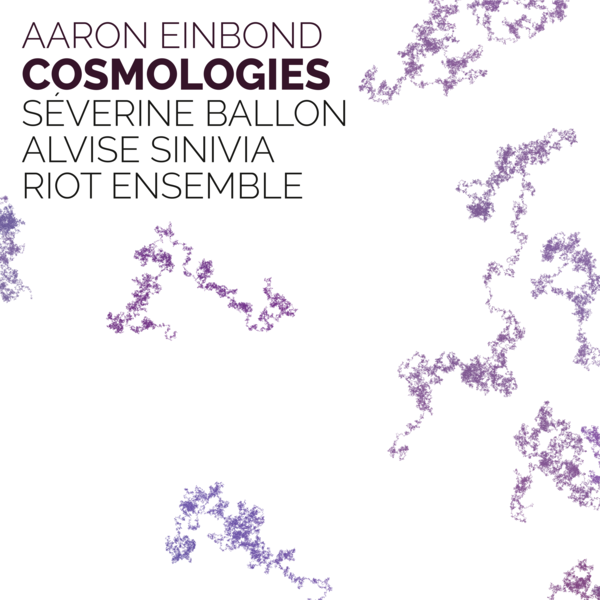
Aaron Einbond
Cosmologies
Séverine Ballon
Alvise Sinivia
Riot Ensemble
Aaron Holloway-Nahum
atd16
What may seem like conventional objects and situations are turned inside out in Einbond’s Xylography and Cosmologies. Closely and ambiently miked, physically and electronically manipulated, from these instruments issue the sound of their materials and of their human music-makers. Listeners feel as up-close as the players, and perhaps even closer, as if they are virtually inside the instruments.
Riot Ensemble
- Alyson Frazier bass flute
- Rocio Bolaños bass clarinet
- Chihiro Ono violin
- Sam Wilson percussion
Critical acclaim
Presque rien could be the watchword for Aaron Einbond’s compositional method. Each of the four pieces on his All That Dust album Cosmologies lurk in the background almost imperceptibly, to the point you just about forget they’re there, catching you unaware when they remind you of their presence.
Tracks
| 1 | Xylography for cello and electronics | 9:24 |
| 2 | Graphology for cello, ensemble and electronics | 10:02 |
| 3 | Cosmologies for piano and electronics | 18:57 |
| 4 | Cosmologies III for electronics | 15:17 |
| TT | 53:41 |
Cosmologies was commissioned with the support of the VERTIGO project as part of the STARTS program of the European Commission, based on technological elements from the Project OM7/om-spat by Jean Bresson in collaboration with Diemo Schwarz and Thibaut Carpentier, IRCAM, Paris, and written in collaboration with Alvise Sinivia. Cosmologies III was supported by an EASTN-DC residency, ZKM, Karlsruhe. Xylography was supported by an Artistic Research Residency, IRCAM, and written in collaboration with Seth Woods, Pierre Morlet, and Séverine Ballon. Graphology was commissioned by the TAK ensemble with support from FACE and is recorded with the kind permission of Edition Gravis Verlag GmbH, Berlin, 2022.
Liner notes
A cellist sits onstage. Her cello is centuries old, a thing of beauty, but turned around to reveal its varnished back. A pianist stands before a Steinway D, the Cadillac of concert grands, but his movements barely graze the instrument. What may seem like conventional objects and situations are turned inside out in Aaron Einbond’s Xylography (2015) and Cosmologies (2020). Closely and ambiently miked, physically and electronically manipulated, from these instruments issue the sound of their materials and of their human music-makers. Listeners feel as up-close as the players, and perhaps even closer, as if they are virtually inside the instruments, able to appreciate the grain of the cello’s back, lightly tapped, or the groan of a detuned string heard through the uneven varnish on the stick of a wooden bow.
In Xylography, sounds picked up by four close and contact microphones on the cello are spatialised through four speakers positioned around the audience. The recording mimics the live experience of the acoustic cello, topped with an electronically fractured image of the instrument from the close-up recordings, and finally a live electronic response ‘improvised’ by the computer. In Cosmologies, above the piano — lid removed, cheekily prepared over the course of the performance with everyday household objects, tin foil, brown wrapping paper, vegetable brush and knitting needles — sits a specialised 3D microphone, which captures everything that happens within and around it. In live performance, the findings from the ambisonic microphone are projected through speakers around the space, immersing the audience in the sound of the piano and the hall. Again, to reproduce this effect, the acoustic piano was recorded and blended with the 3D version and the computer’s volatile 3D responses, all of which the listener may experience spatially with high-quality headphones.
Xylography and Cosmologies are both diptychs; their second parts are Graphology and Cosmologies III respectively. While they can be performed independently, when done together the movements are overlapped, as in the version released on CD, which presents the two parts dovetailed together (the digital download keeps them separate). The sound-worlds change between movements. The four ensemble players of Graphology are not subjected to the same amplification as the solo cello, but they surround the audience to form a physical equivalent of the earlier movement’s immersive electronics. In Cosmologies III, the concert hall is infiltrated by noises recorded from the outside world: a window cracked open to the crowds milling around the fountain outside IRCAM, in Paris, where the piece was made; a café heard from outside and within; traffic noise far away and nearby. Sounds recorded from the piano are manipulated to morph into the field recordings, seemingly becoming more alienated in the process. They might be heard as a reminder of that moment when, Einbond relates, ‘according to theories of cosmic inflation, a fraction of a second after it began, the universe was the size of a grand piano’. The concert hall, and the instruments, players, and listeners that inhabit it, become a space charged with potential, imagined, emerging sounds.
Laura Tunbridge